FrodoKEM is a post-quantum key encapsulation mechanism designed to protect digital communications in a future where quantum computers could break widely used cryptographic schemes like RSA, Diffie-Hellman, and elliptic curve cryptography. As quantum processors, such as Microsoft’s Majorana 1 chip, progress toward practical usability, existing public-key protocols face increased risk due to algorithms like Shor’s, which can efficiently factor large numbers and solve discrete logarithm problems—undermining the security foundations of much of today’s cryptography.
Addressing these vulnerabilities, government agencies and cryptographers have accelerated the development and evaluation of quantum-resistant algorithms under efforts like the US National Institute of Standards and Technology (NIST) Post-Quantum Cryptography Standardization project. While NIST has standardized efficient lattice-based schemes like ML-KEM (formerly CRYSTALS-Kyber), FrodoKEM is seeing growing international support and standardization, particularly from European agencies and the International Organization for Standardization (ISO). FrodoKEM distinguishes itself through its conservative design, minimizing reliance on algebraic structure by building on generic, unstructured lattices. Its foundation is the Learning with Errors (LWE) problem—a hard mathematical challenge even for quantum computers, ensuring robust security against both classical and quantum attacks.
FrodoKEM’s security comes at a trade-off—its unstructured lattice approach results in larger key sizes and increased computational requirements compared to structured alternatives like ML-KEM. However, it offers a simpler, more transparent structure for implementation and verification, and is less susceptible to potential future advances in cryptanalysis. Its operational model follows the standard KEM paradigm with three main steps: key generation, encapsulation (securely sharing a session key), and decapsulation (recovering the shared key). Benchmarks indicate that even with higher resource requirements, FrodoKEM’s performance remains viable for most practical and security-sensitive applications, providing advantages in some areas over code-based alternatives such as Classic McEliece, particularly in terms of public key size and operational efficiency.
With a design philosophy focused on long-term resilience and ease of implementation, FrodoKEM is regarded as a leading choice for organizations concerned with cryptographic longevity in a rapidly evolving threat landscape. The ongoing endorsement by standardization bodies and its solid mathematical foundation position FrodoKEM as a crucial component in the post-quantum cryptographic toolkit, ready to secure sensitive communications and infrastructure as quantum computing capabilities mature.

